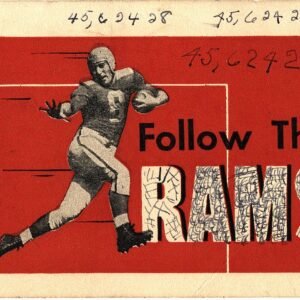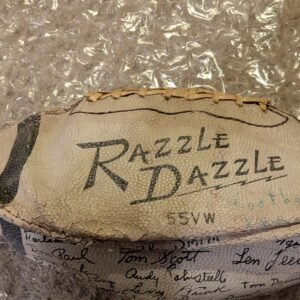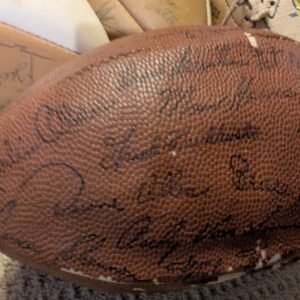The 1948 Los Angeles Rams had a notable season, one that featured strong individual performances but also a few challenges. The 1948 season was a step forward for the Rams, even though they still faced difficulties in competing for the top spots in the NFL.
Here’s a breakdown of the 1948 Los Angeles Rams season:
Key Points about the 1948 Los Angeles Rams:
-
Record:
- The 1948 Rams finished the season with a 8-4 record, the same as their record in 1947. They once again finished in 2nd place in the NFL Western Division, behind the Chicago Bears, who would dominate the division that year.
- Despite a strong record, the Rams were unable to secure a spot in the playoffs. The team’s inability to win the division or secure a postseason berth was a recurring issue in the late 1940s.
-
Coaching:
- Pete Cawthon returned as head coach for the 1948 season, having been with the team since the move to Los Angeles in 1946. Under his leadership, the Rams were competitive but struggled to compete with the league’s top teams, particularly the Chicago Bears.
- The Rams would continue to be one of the more offensive-oriented teams, but they still faced struggles in key areas that would lead to further changes after the season.
-
Key Players:
- Bob Waterfield (quarterback) remained one of the NFL’s top quarterbacks. He had another solid year and was key to the Rams’ offense, leading the passing game and contributing both with his arm and as a leader on the field.
- Tom Fears, the Rams’ star wide receiver, had a fantastic season. He led the team in receiving yards and touchdowns, becoming one of the top wideouts in the league. Fears’ ability to make big plays was one of the main weapons in the Rams’ offensive arsenal.
- Ace Parker also contributed as a versatile back, although he began to age and was no longer in his prime years by 1948.
- Elroy “Crazylegs” Hirsch, another key player for the Rams, had a strong impact during this period. Hirsch was a standout wide receiver and one of the first true deep threats in the NFL, providing a dangerous option for Waterfield.
-
Offense:
- The Rams had a potent offensive attack in 1948, featuring a mix of strong passing from Bob Waterfield and receiving from Tom Fears and Elroy Hirsch. The Rams ranked near the top of the league in total yards and points scored.
- The passing game, led by Waterfield and supported by Fears and Hirsch, was one of the best in the NFL, though they still struggled to consistently overpower stronger defensive teams like the Chicago Bears.
-
Defense:
- The Rams’ defense was not as strong as their offense, which hurt them in key games. While they had some talented defensive players, they were inconsistent at times and couldn’t match the defense of the top teams in the league.
- This was one of the factors that led to the Rams’ inability to reach the playoffs, despite their solid offensive showing.
-
End of the Pete Cawthon Era:
- After the 1948 season, Pete Cawthon was replaced as head coach. His inability to lead the Rams to a championship or even a playoff berth led to his dismissal, and the franchise would hire Joe Stydahar (a former NFL player) to take over the following year. Stydahar’s hiring was part of an effort to take the team to the next level and challenge for the NFL Championship.
-
NFL Developments:
- The 1948 season was part of a growing NFL that was expanding in both its fan base and competition. The Chicago Bears were one of the dominant teams in the league during this era, which made it difficult for teams like the Rams to compete at the very top.
- The Cleveland Browns had also been added to the NFL in 1946, but their success wasn’t fully felt until later, so the Rams’ primary challenge at this time was with teams like the Bears.
Legacy:
- The 1948 Los Angeles Rams were a team that had promise but was still lacking the consistency needed to break through in a very competitive league. Their 8-4 record showed that they were a good team, but they still couldn’t find a way to consistently challenge for championships.
- Players like Tom Fears, Bob Waterfield, and Elroy Hirsch were critical parts of the Rams’ offensive success during this era and helped lay the foundation for the franchise’s future.
- The Rams’ continued struggles in the 1940s would lead to coaching changes and further roster improvements in the following seasons. Despite these challenges, the team was beginning to establish itself in Los Angeles, setting the stage for future success.
Conclusion:
The 1948 Los Angeles Rams were a competitive team, finishing with an 8-4 record and ranking near the top of the league offensively. Despite strong performances from key players like Bob Waterfield and Tom Fears, the Rams were still unable to compete for the division title or make the playoffs, which led to changes in coaching and personnel in the following seasons. The 1948 season was an important building block for the franchise, though they would need to make further improvements to become true championship contenders.
Head Coach: Clark Shaughnessy
- To be listed, a player must have played at least one game for the team during this season.
- * Hall of Fame
- + Primary starter
| Pos | # | Player | GP | GS | Start Pos | Exp | DOB | Ht | Wt | College | |
|---|---|---|---|---|---|---|---|---|---|---|---|
| HB/DB/FB/LB | Bob Agler | 8 | 1 | 03/13/1924 | ‘ “ | Otterbein | |||||
| HB/DB | Jack Banta | 12 | 6 | 11/19/1917 | ‘ “ | Southern California | |||||
| DT/T | Gil Bouley | 12 | 4 | 11/15/1921 | ‘ “ | Boston College | |||||
| DE/E | Larry Brink | 11 | R | 09/12/1923 | ‘ “ | Northern Illinois | |||||
| DT/T | Ed Champagne | 12 | 2 | 12/04/1922 | ‘ “ | Louisiana State | |||||
| HB/DB | Joe Corn | 9 | 1 | 10/05/2023 | ‘ “ | ? | |||||
| LB/FB/DB | Gerry Cowhig | 12 | 2 | 07/05/1921 | ‘ “ | Notre Dame | |||||
| E/DB/DE | Don Currivan | 10 | 6 | 03/06/1920 | ‘ “ | Boston College | |||||
| G/LB | Bob David | 3 | 2 | 01/15/1921 | ‘ “ | Villanova | |||||
| G/LB | Hal Dean | 11 | 2 | 10/30/1922 | ‘ “ | Ohio State | |||||
| DB/HB | Bob DeFruiter | 3 | 4 | 06/03/1918 | ‘ “ | Nebraska | |||||
| G | Roger Eason | 10 | 4 | 07/31/1918 | ‘ “ | Oklahoma | |||||
| TE/DB | * | Tom Fears | 12 | 1 | 12/03/1923 | ‘ “ | UCLA | ||||
| G/LB | Jack Finlay | 12 | 2 | 09/08/1921 | ‘ “ | UCLA | |||||
| HB/DB/TB | Fred Gehrke | 12 | 5 | 04/24/1918 | ‘ “ | Utah | |||||
| QB/DB | Jim Hardy | 12 | 3 | 04/24/1923 | ‘ “ | Southern California | |||||
| E/DE | Red Hickey | 12 | 5 | 02/14/1917 | ‘ “ | Arkansas | |||||
| FB | Dick Hoerner | 12 | 2 | 07/25/1922 | ‘ “ | Iowa | |||||
| LB/FB/BB | Bob Hoffman | 11 | 5 | 12/13/1917 | ‘ “ | Southern California | |||||
| HB/DB | Les Horvath | 12 | 2 | 10/12/1921 | ‘ “ | Ohio State | |||||
| DE/E | Frank Hubbell | 12 | 2 | 01/19/1922 | ‘ “ | Tennessee | |||||
| T/DT | Dick Huffman | 12 | 2 | 03/27/1923 | ‘ “ | Tennessee | |||||
| DB/E | Tom Keane | 11 | R | 09/07/1926 | ‘ “ | West Virginia | |||||
| G/LB | Mike Lazetich | 12 | 4 | 08/27/1921 | ‘ “ | Michigan | |||||
| HB/DB/WB | Dante Magnani | 8 | 7 | 03/16/1917 | ‘ “ | St. Mary’s (CA) | |||||
| C | Jack Martin | 12 | 2 | 04/10/1922 | ‘ “ | Navy | |||||
| DB/FB/LB | Jim Mello | 3 | 2 | 11/08/1920 | ‘ “ | Notre Dame | |||||
| C/LB | Fred Naumetz | 11 | 3 | 03/28/1922 | ‘ “ | Boston College | |||||
| LB/C | Don Paul | 11 | 1 | 03/18/1925 | ‘ “ | UCLA | |||||
| T | Joe Repko | 12 | 3 | 03/15/1920 | ‘ “ | Boston College | |||||
| QB | Paul Rickards | 3 | 1 | 06/30/1926 | ‘ “ | Pittsburgh | |||||
| HB/DB/RB | Bruce Smith | 8 | 4 | 02/08/1920 | ‘ “ | Minnesota | |||||
| DE/E/T | Bill Smyth | 11 | 2 | 04/08/1922 | ‘ “ | Penn State | |||||
| T | Al Sparkman | 12 | 1 | 02/17/1926 | ‘ “ | Texas A&M | |||||
| HB/DB | Kenny Washington | 10 | 3 | 08/31/1918 | ‘ “ | UCLA | |||||
| QB/DB | * | Bob Waterfield | 11 | 4 | 07/26/1920 | ‘ “ | UCLA | ||||
| FB/LB | Pat West | 4 | 4 | 02/21/1923 | ‘ “ | Southern California | |||||
| G/LB | Ray Yagiello | 12 | R | 09/21/1923 | ‘ “ | Catawba | |||||
| DE/E | Jack Zilly | 12 | 2 | 11/11/1921 | ‘ “ | Notre Dame |





